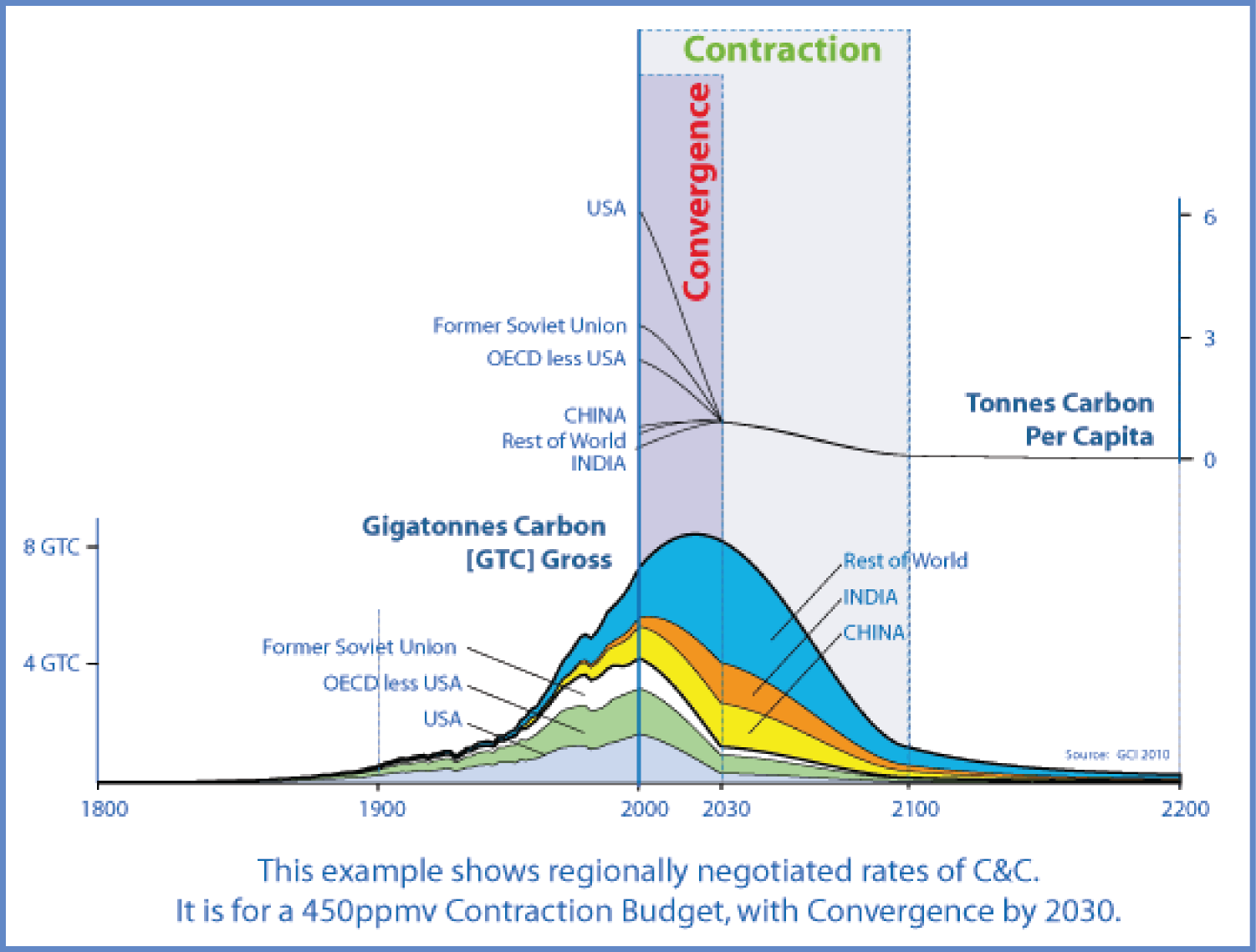Dear Aubrey
I completely support the adoption of the Contraction and Convergence Operational Framework submission to the UN Climate Negotiations.
This climate agreement model is a very transparent and fair methodology for setting the framework for convergence of carbon emission containment and regenerative ecological habitation by all countries. It is a very clear and rational approach based upon per capita allowances. It's a necessary step because the timeline to reduce human carbon emissions to zero is only 50 years, due to recent documented changes in the climate system.
Double-Jeopardy of unsustainable growth of human population demands and concomitant increased costs of climate damage is a very clear risk model, and it's shared by every country on the globe. It's the limit to growth problem, and the methods by which this risk is contained are grounded in the rapid evolution of renewable energy, conservation and ecological recovery. These things are eminently doable, as is evidenced by the rapid development of net-zero strategies by the building industry, and the capability for rapid energy production transformation as outlined by the Rocky Mountain Institute. Many regional projects around the globe have already regenerated their rivers, forests and resources as part of their development.
The costs of the impact of climate change, as the financial community has observed through its re-insurers, are running well ahead of rate of growth of the global economy. This creates destructive economic as well as physical vectors and generates a future of great uncertainty for all countries. Destabilization of climate, food and water supplies, energy and resources come as an ultimate price of unchecked growth, placing this huge cost upon every country on the planet. Thus the argument that carbon emissions can continue going forward is shown to be utterly destructive to all human societies and living systems by the projections in this model.
Therefore the choice is not whether to agree, but how swiftly this method needs to be put into place. The sooner it is achieved, the better the future is for all countries, and the damage to human life, as well as to all life and ecological systems can be minimized both economically and in terms of resources.
This is a shift in the idea that human existence requires continuous expansion; rather it focuses on the quality of life on earth and the idea that a less mechanistic existence requires fewer resources and fosters the regeneration of that which supports life for all. Human suffering and extinction of natural processes are not rational choices under this model, which is something that can be agreed to in principle very quickly by all countries; the stakes are clear.
How this is achieved is left up to individual countries and fostered by ability of low-emission countries to create value for their renewal strategies and low carbon levels. This creates an incentive game where this value is sought after, thus creating a market for non-emission of carbon. It's the inverse of how fossil-fueled capitalism works now, but uses the same kind of fiscal incentives, and creates an entire new paradigm for human existence within the natural world that stabilizes the future and allows the earth to regenerate.
Sincerely,
Laurie Barlow,
AIA San Marino,
California
United States of America
http://www.barlowcoweb.com/
http://greenswardcivitas.blogspot.com/ Full article here - "A Fair Consensus" by Laurie Barlow
Full article here - "A Fair Consensus" by Laurie BarlowIn support of the Contraction and Convergence submission to the UN Climate Negotiations (UNFCCC) in February of this year by Aubrey Meyer (in video above) of the Global Commons Institute, I'm dedicating this post to the implementation of its framework.
This climate agreement model is a very transparent and fair methodology for setting the framework for convergence of carbon emission containment and regenerative ecological habitation by all countries. It is a very clear and rational approach based upon per capita allowances. It's a necessary step because the timeline to reduce human carbon emissions to zero is only 50 years, due to recent documented changes in the climate system.
Double-Jeopardy of unsustainable growth of human population demands and concomitant increased costs of climate damage is a very clear risk model, and it's shared by every country on the globe. It's the limit to growth problem, and the methods by which this risk is contained are grounded in the rapid evolution of renewable energy, conservation and ecological recovery. These things are eminently doable, as is evidenced by the rapid development of net-zero strategies by the building industry, and the capability for rapid energy production transformation as outlined by the Rocky Mountain Institute. Many regional projects around the globe have already regenerated their rivers, forests and resources as part of their development.
The costs of the impact of climate change, as the financial community has observed through its re-insurers, are running well ahead of rate of growth of the global economy. This creates destructive economic as well as physical vectors and generates a future of great uncertainty for all countries. Destabilization of climate, food and water supplies, energy and resources come as an ultimate price of unchecked growth, placing this huge cost upon every country on the planet. Thus the argument that carbon emissions can continue going forward is shown to be utterly destructive to all human societies and living systems by the projections in this model.
Therefore the choice is not whether to agree, but how swiftly this method needs to be put into place. The sooner it is achieved, the better the future is for all countries, and the damage to human life, as well as to all life and ecological systems can be minimized both economically and in terms of resources.
This is a shift in the idea that human existence requires continuous expansion; rather it focuses on the quality of life on earth and the idea that a less mechanistic existence requires fewer resources and fosters the regeneration of that which supports life for all. Human suffering and extinction of natural processes are not rational choices under this model, which is something that can be agreed to in principle very quickly by all countries; the stakes are clear.
How this is achieved is left up to individual countries and fostered by ability of low-emission countries to create value for their renewal strategies and low carbon levels. This creates an incentive game where this value is sought after, thus creating a market for non-emission of carbon. It's the inverse of how fossil-fueled capitalism works now, but uses the same kind of fiscal incentives, and creates an entire new paradigm for human existence within the natural world that stabilizes the future and allows the earth to regenerate.
The UN Climate Change Conference last December unfortunately came to a close with no agreement on global NEA goals. National Emissions Allocations are distributed through a global agreement of quotas of allowed emissions per capita for each country. This was proposed by the Global Commons Institute in 2000, and is conceptually accepted as a methodology by many countries. The NEA- based contraction convergence model applies an emissions cap to each country that declines rapidly over 40 years in order to reach the desired global atmospheric goal of 430 ppmv by 2052 (we're at 395 now). It's a cooperative effort, with developed nations assisting the third world countries in their reduction via the transfer of energy and pollution control technologies. Its strategy is that rapidly developing countries such as China and India must quickly pull back on their increasing emissions, and the UK and USA must simply implement immediate reductions in GHG emissions, period. This proved untenable to developed countries at Durban in December 2011, and so no global agreement was achieved. There is a consensus on the model, however, so the negotiation continues.
The Global Commons Institute [GCI] was founded in 1990. It has developed thisemissions management model that has gained support by many countries as a fair and effective model for reducing carbon emissions.
Mindfulness.
A proposed strategy for counteracting human activity in the biosphere as a comprehensive approach is called the Contraction and Convergence model. It sets up the framework whereby all countries accept a carbon budget that shrinks rapidly during the convergence phase between 2000 and 2030, resulting in a diminishment of carbon emissions to the levels seen in 1900 within 200 years. Will this be sufficient to preserve the planetary systems as we know them today? We may have a difficult time maintaining human life, not to mention the rest of the life systems that give us sustenance.
Mindfulness is concentration on the nature of life and all its parts. This way of seeing can allow us to act in effective ways that return our world to its natural balance and respect for life, rather than mindlessly burning resources into destruction. The science says that, and the experiential says that. Even simple logic says that.
So what are we waiting for?
Civitas on Contraction and Convergence
Back to UNFCCC Submission Back to Signatory List



